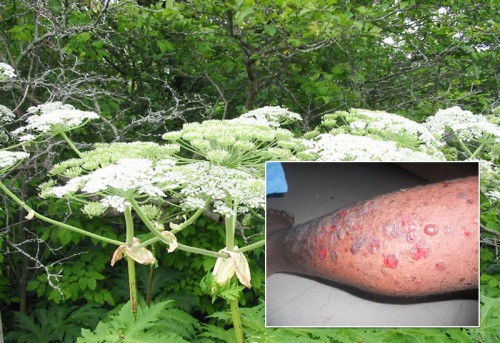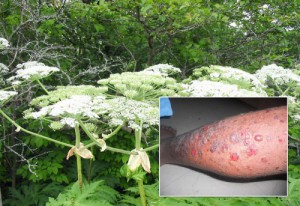AUNDECK OMNI KANING—A 20-year-old Aundeck Omni Kaning (AOK) man had an encounter with the invasive giant hogweed plant late last month, an encounter that’s left him with wounds, scars and a loss of tolerance to sunlight.
Nick McGraw explained that he was hired to do some brush cutting in the community near the lake where he believes he encountered giant hogweed, inadvertently cutting the plant down. Mr. McGraw was wearing only shorts and a T-shirt while performing the task, leaving his skin exposed to the plant’s harmful sap.
“The rash came two days later,” Mr. McGraw explained. “It started out as a bunch of little red dots. At first I thought it was just poison ivy, but by one week, I had these huge blisters.”
The young man said the majority of the rash was located on the left side of his body, his arm and leg, and gained a lot of attention while he was attending job interviews with potential employers who urged him to seek medical attention. He finally did just that, attending the emergency room of the Manitoulin Health Centre in Little Current.
“The doctor said ‘that’s not poison ivy’ and walked out to do some research,” Mr. McGraw recalled. “I had like 40 different doctors and nurses come through my room.”
He explained the formations on his leg to be large, painful pus-filled bubbles that were excruciating for four straight days. “My legs and feet were swollen too.” Mr. McGraw added. “A nurse had to come every day to change my bandages.”
For weeks, the young man had to hide himself away, making sure his skin wasn’t exposed to sunlight should his condition worsen. According to Jessica Myers, invasive species coordinator for the Manitoulin Area Stewardship Council, when exposed to skin, the compounds in the sap can cause major burns that are intensified by exposure to ultraviolet light from the sun, leaving permanent scars. If sap contacts the eyes, it could possibly result in temporary or permanent blindness, she added.
“The hallmark characteristics of this plant include its height and flower shape,” Ms. Myers explained. “This plant can grow up to five and a half meters tall and the flowers look much like a giant Queen Anne’s lace, with white flowers in umbrella-shaped clusters that can be as wide as two-and-a-half feet. The stem is a purple spotted, bristly, hollow green stem. The leaves on the plant are dark green, and can grow up to one and a half meters wide.”
She explained that cow parsnip and Angelica are easily mistaken for giant hogweed as their flowers resemble the dangerous plant. However, neither of these native plants grow taller than two metres and have stems that are solid in colour and leaves that are not as deeply grooved, she continued.
“Giant hogweed is present on Manitoulin and unfortunately there is no 100 percent effective way of removing it because new shoots will often re-grow from dead ones,” Ms. Myers confirmed. “However, to prevent further infestation, you can remove the seed heads, place them in a plastic bag and allow the heat from sunlight to kill the seeds. The stems can then be treated with a pesticide. Yearly treatments will probably be needed. Always use caution by wearing protective clothing, gloves, masks and safety goggles.”
Mr. McGraw is well on the mend now, but will have to stay clear of sun exposure for the next four years, as the symptoms could return.
AOK Chief Patsy Corbiere told The Expositor that since Mr. McGraw’s exposure, hogweed has been located in the old subdivision (located on top of the hill, behind the band office) but as yet, has not been located at the beach area. She explained that band residents are being educated through community newsletters and photos of the noxious plant.
If you think you have discovered giant hogweed, Ms. Myers urges Island residents to contact the Invasive Species Hotline at 1-800-563-7711 or by emailing her at jessicam_invasive@hotmail.com or by calling her at 705-859-1653.




